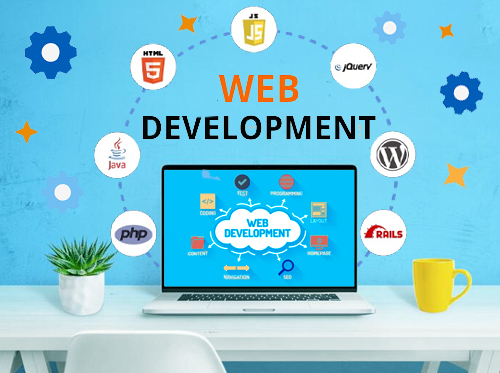Website Development
Web development services is important to online business who work in website. Web development is the process of creating, building, and maintaining websites. It involves a combination of coding, design, content creation, and backend infrastructure that brings a website to life. In today’s digital world, a well-developed website is not just an online presence—it’s a powerful tool for branding, marketing, customer service, and sales.
The process of website development can be broken into two main areas: front-end development and back-end development.
Front-end development (also known as client-side development) focuses on everything a user sees and interacts with. This includes the layout, navigation, fonts, colors, buttons, images, and overall user experience (UX). Front-end developers use programming languages like HTML, CSS, and JavaScript to ensure the site is visually appealing and responsive across devices.
Back-end development (server-side development) is the behind-the-scenes functionality of a website. This includes databases, server configuration, APIs, and logic that powers the website. It ensures that forms submit data, users can log in securely, and everything works smoothly. Common back-end technologies include PHP, Python, Node.js, Ruby, and databases like MySQL or MongoDB.
Website development also includes Content Management Systems (CMS) like WordPress, Shopify, and Wix, which allow non-technical users to update and manage content without coding. CMS platforms are ideal for blogs, e-commerce, and business websites that require regular updates.
A good website development process includes several stages:
Planning: Define the purpose, audience, features, and content requirements.
Design: Create wireframes and visual mockups to guide the look and feel of the site.
Development: Write code to build the website structure and functionality.
Content Creation: Add text, images, videos, and SEO-friendly copy.
Testing: Check for bugs, broken links, mobile responsiveness, and browser compatibility.
Launch: Deploy the site to a live server.
Maintenance: Update content, fix bugs, and improve performance over time.
A successful website must be responsive, meaning it looks and functions well on desktops, tablets, and mobile devices. It should also be SEO-optimized, so search engines can crawl and rank its content. Fast loading speed, easy navigation, clear calls-to-action (CTAs), and secure HTTPS protocols are all critical for user experience and trust.
For e-commerce, custom development or platforms like Shopify or WooCommerce enable secure online shopping, payment gateway integration, product management, and order tracking.
In modern web development, tools and frameworks such as React, Vue.js, Tailwind CSS, and Bootstrap help streamline the design and build process. Developers also use version control systems like Git to manage and collaborate on code.
In conclusion, website development is a key investment for any business or personal brand. A well-developed website builds credibility, improves visibility, and serves as a 24/7 digital storefront. Whether you’re building a simple landing page or a complex web application, the focus should be on user experience, performance, and functionality. With the right strategy and tools, your website can become your most valuable digital asset.

Why businesses need Web Development Services?
1. Establishing Credibility and Professionalism:
- First Impression: Your website is often the first interaction a potential customer has with your business. A well-designed, modern, and easy-to-navigate website immediately conveys professionalism and builds trust. Conversely, an outdated or poorly designed website can deter customers and make your business seem unreliable.
- Legitimacy: In the absence of a physical storefront, a website acts as your digital address, validating your business’s existence and legitimacy to potential clients, partners, and investors.
- Showcase Expertise: A website provides a platform to showcase your company’s mission, values, expertise, team, and achievements through an “About Us” page, case studies, portfolios, and testimonials.
2. 24/7 Online Presence and Accessibility:
- Always Open: Unlike a physical store with limited hours, a website operates 24/7, 365 days a year. This means customers can access information, browse products, make purchases, or submit inquiries at any time, from anywhere in the world.
- Global Reach: A website breaks geographical barriers, allowing businesses to reach a wider audience beyond their local area, potentially expanding into national or international markets.
3. Powerful Marketing and Sales Tool:
- Central Hub: Your website serves as the central hub for all your digital marketing efforts (SEO, social media, email marketing, paid ads). All these channels typically drive traffic back to your website for conversion.
- Lead Generation: Websites can incorporate features like contact forms, live chat, newsletter sign-ups, and downloadable resources (e.g., ebooks, whitepapers) to capture leads directly.
- Showcase Products/Services: It’s your ultimate digital catalog or brochure, allowing you to showcase your offerings with high-quality images, detailed descriptions, videos, and customer reviews. For e-commerce businesses, it’s the storefront itself.
- Direct Sales: E-commerce functionality allows businesses to sell products or services directly online, opening up new revenue streams.
4. Enhanced Customer Service and Engagement:
- Information Hub: A website can house frequently asked questions (FAQs), knowledge bases, support forums, and clear contact information, empowering customers to find answers independently, reducing the burden on your customer service team.
- Direct Communication: Features like contact forms, chatbots, and integrated live chat facilitate direct and immediate communication with customers, improving their experience.
- Gather Feedback: Websites can easily integrate survey forms, review systems, and feedback mechanisms to gather valuable insights from customers, helping you improve products, services, and overall operations.
5. Competitive Advantage:
- Level Playing Field: A professionally developed website helps even small businesses compete with larger corporations by presenting a polished and accessible online presence.
- Differentiation: A unique, user-friendly, and content-rich website can differentiate your business from competitors who might have outdated or less effective online presences.
- Market Insights: By tracking website analytics, businesses can gain invaluable insights into customer behavior, popular products/pages, traffic sources, and conversion funnels, enabling data-driven strategic decisions to stay ahead of the competition.
6. SEO Benefits and Discoverability:
- Search Engine Visibility: A well-developed website is the foundation for effective SEO (Search Engine Optimization). Proper website structure, clean code, fast loading speeds, and mobile responsiveness are all critical factors that search engines like Google consider for ranking.
- Organic Traffic: Ranking high in search results means more organic traffic to your site, bringing in highly qualified leads who are actively searching for what you offer.
7. Data Collection and Analytics:
- Behavioral Insights: Web development allows for the integration of analytics tools (like Google Analytics) that track user behavior on your site. This data helps you understand what content resonates, where users drop off, and how they navigate, enabling continuous optimization.
- Personalization: Data gathered from website interactions can be used to personalize user experiences, offer tailored recommendations, and improve marketing effectiveness.

Importance of Web Development Services in 2025?
1. AI-Driven Personalization and Intelligence:
- Hyper-Personalized Experiences: In 2025, generic websites are losing relevance. Users expect highly personalized content, product recommendations, and interactions. Web development services are essential for integrating AI and machine learning capabilities to analyze user behavior in real-time and dynamically serve up tailor-made experiences. This includes AI-powered chatbots for instant support, predictive analytics for content delivery, and smart search functionalities.
- Automated Development & Optimization: AI tools are increasingly assisting web developers themselves, automating mundane coding tasks, suggesting code snippets, detecting errors, and even optimizing website elements for better performance. Businesses need web development services that can leverage these AI advancements to build more efficient, robust, and intelligent websites.
2. Progressive Web Apps (PWAs) as the Standard:
- App-Like Performance, Web Accessibility: PWAs offer the best of both worlds: the speed, offline capabilities, and push notifications of native mobile apps, combined with the accessibility and lower development costs of web pages.
- Enhanced User Experience & Retention: In 2025, users expect instant load times and seamless interactions. Web development services are crucial for building PWAs that provide a fluid, engaging experience across all devices, leading to higher user retention, lower bounce rates, and increased conversions, all without the friction of app store downloads.
3. Uncompromising Cybersecurity is a Business Imperative:
- Evolving Threat Landscape: Cyber threats are becoming more sophisticated daily. In 2025, neglecting website security is a massive risk. Web development services are vital for implementing robust security measures, including secure coding practices, continuous vulnerability assessments, advanced encryption (HTTPS is non-negotiable), multi-factor authentication (MFA), and secure API integrations.
- Data Privacy Compliance: With stricter data privacy regulations (like GDPR and similar laws expanding globally, including in India), businesses need web development services to ensure their websites are fully compliant. This involves transparent data collection practices, user consent management systems, and secure data storage. A data breach can lead to severe financial penalties, reputational damage, and loss of customer trust.
4. Immersive and Interactive User Interfaces (UI/UX):
- Beyond Static Pages: User expectations for engaging experiences are higher than ever. Web development in 2025 focuses on creating dynamic, interactive, and visually appealing interfaces. This includes motion UI (micro-animations, scrolling effects), 3D elements, and potentially early integrations of AR/VR elements for richer product visualization and immersive experiences.
- Seamless User Journeys: A strong UX design is fundamental. Web development services ensure intuitive navigation, clear calls-to-action, and a frictionless user journey that guides visitors effortlessly towards conversion goals.
5. Mobile-First Development and Cross-Platform Compatibility:
- Mobile Dominance: The majority of internet traffic originates from mobile devices. In 2025, a “mobile-first” approach is no longer a trend but a standard. Web development services ensure websites are inherently responsive and adapt seamlessly to various screen sizes and devices, providing an optimal experience for all users.
- Accessibility: Beyond responsiveness, inclusivity and accessibility are crucial. Websites must be developed to cater to users with disabilities, adhering to WCAG guidelines, which not only broadens your audience but also enhances your SEO.
6. Voice Search Optimization and New Interaction Modalities:
- Conversational Search: With the rise of smart speakers and voice assistants, voice search is an increasingly important avenue for discovery. Web development services are needed to optimize websites for conversational queries and natural language processing (NLP), ensuring businesses are found through voice searches.
- Beyond Clicks: This opens up new interaction modalities that professional web developers are equipped to integrate.
7. Scalability, Performance, and Cloud Integration:
- Demands for Speed: Users expect websites to load almost instantly. Web development services focus on performance optimization, including clean code, optimized images, efficient caching, and leveraging technologies like WebAssembly (Wasm) for high-performance web applications.
- Cloud-Native Architectures: Businesses increasingly rely on cloud computing for scalability, flexibility, and cost-efficiency. Web development services are crucial for building cloud-native applications, utilizing serverless architectures, and integrating with robust cloud platforms (AWS, Azure, Google Cloud) to handle fluctuating traffic and rapid growth.